Europe Milk Protein Market Size
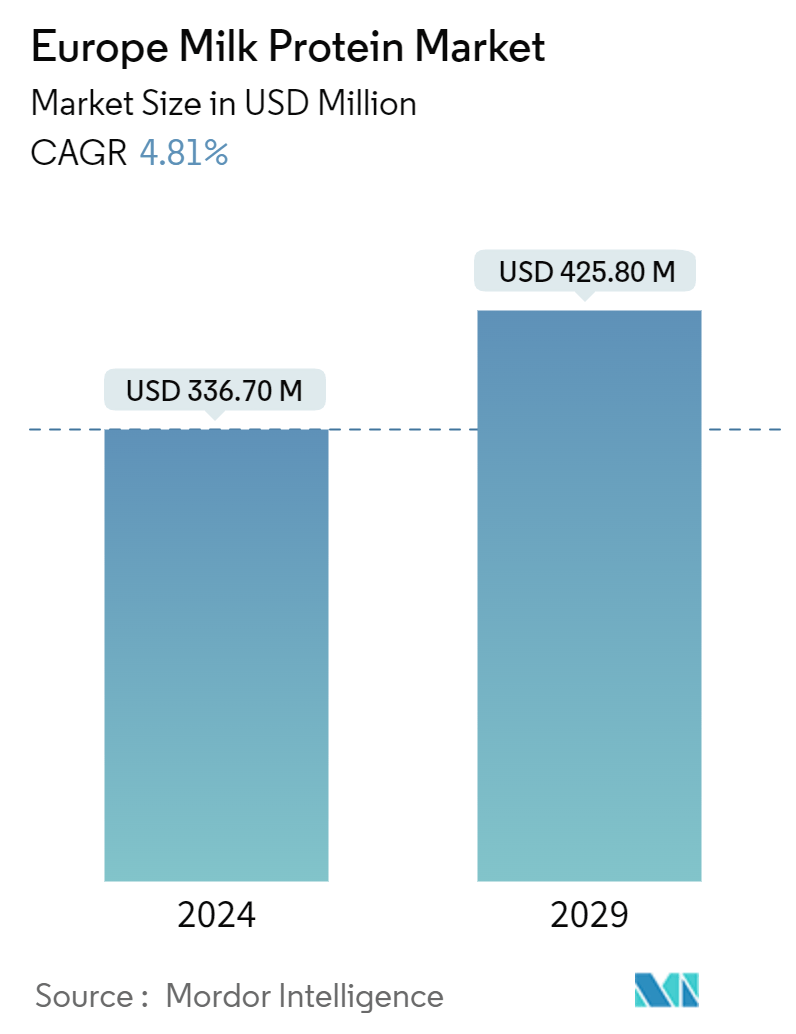
| Study Period | 2019 - 2029 |
| Market Size (2024) | USD 336.70 Million |
| Market Size (2029) | USD 425.80 Million |
| CAGR (2024 - 2029) | 4.81 % |
| Largest Market | Turkey |
| Market Concentration | Low |
Major Players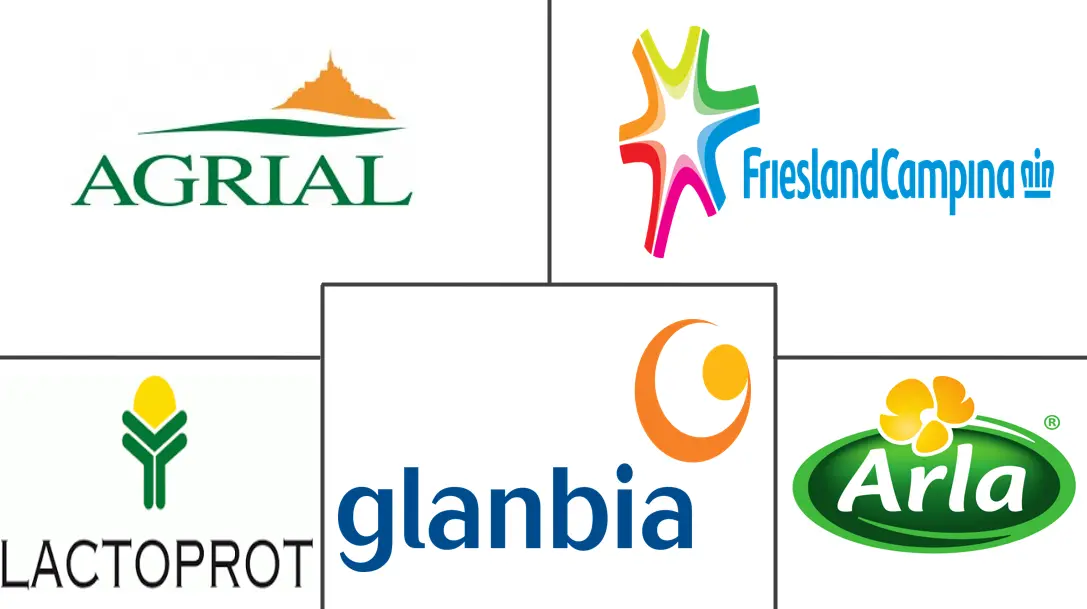
*Disclaimer: Major Players sorted in no particular order |
Europe Milk Protein Market Analysis
The Europe Milk Protein Market size is estimated at USD 336.70 million in 2024, and is expected to reach USD 425.80 million by 2029, growing at a CAGR of 4.81% during the forecast period (2024-2029).
- Demand for milk protein-based products, such as protein supplements and functional foods, has increased due to the trend of embracing protein-rich diets for fitness and active lifestyles; in the preparation of a wide variety of food products, dairy proteins such as whey protein, casein, and milk protein act as gelling agents, thickening agents, carriers, foaming agents, and texture modifiers. It is also extensively used in a variety of sectors, such as textiles, personal care, nutrition, and animal feed.
- The growing popularity of nutritional supplements and sports nutrition, where milk protein is a popular ingredient because it contains high-quality protein. The popularity of plant-based milk substitutes has increased the need for dairy protein products as an option to accommodate various dietary choices.
- Demand for milk protein sourced from organic and non-genetically modified organism (GMO) sources has increased as a result of consumers' preference for organic and clean-label products. For instance, per capita consumption of organic food in the European Union was EUR 104.3 (USD 123.35) in 2021, according to the International Federation of Organic Agriculture Movements (IFOAM )-Organics International.
- The market has grown as a result of the inclusion of milk proteins in a variety of functional snacks and drinks, such as those that are protein-rich. The food and beverages segment leads the market, driven by the bakery and dairy and dairy alternative products.
- The constant developments in product formulations utilizing milk proteins for diverse applications, such as in bread, confectionery, and dairy goods, in the food and beverage industry. The rise in functional food and beverage is boosting the demand for protein ingredients. In terms of convenience and product formulations, milk protein innovation is gaining traction in the market, mainly in the bakery and breakfast cereal sub-sectors.
Europe Milk Protein Market Trends
Rising Demand for functional Food Drives the Market
- Innovation in the dairy sector, particularly in the milk protein market, has been sparked by the rising demand for functional food. Customers are searching for goods that give not only needed nutrition but also certain health advantages, including immune support, weight management, and recovery of muscles. Whey and casein, two milk proteins with high protein content and a variety of useful characteristics, are extremely valuable. Consumption and production of protein products are rising in the region.
- For instance, protein meal production volume in the European Union was 28,718.55 thousand tons in 2022, according to the Organisation for Economic Co-operation and Development (OECD). They are included in a variety of functional food items, including protein-fortified drinks, sports nutrition, meal replacements, and nutritional supplements.
- Furthermore, protein supplements are currently used extensively due to rising healthcare awareness among the public and worries about obesity. Customers are shifting their focus on eating nutritious foods and increasing their protein intake to get extra benefits from protein supplements created with milk protein, which in turn is fueling the increase of milk protein.
- The emergence of functional foods has given dairy companies new opportunities to design and promote products that meet the needs of health-conscious customers looking for convenient methods to enhance their well-being.
- As the demand for nutrient-dense foods using milk concentrates rises, producers of milk protein concentrate components are heavily investing in research and development. A new generation of milk protein concentrates with an improved flavor and nutrient profile is being developed.
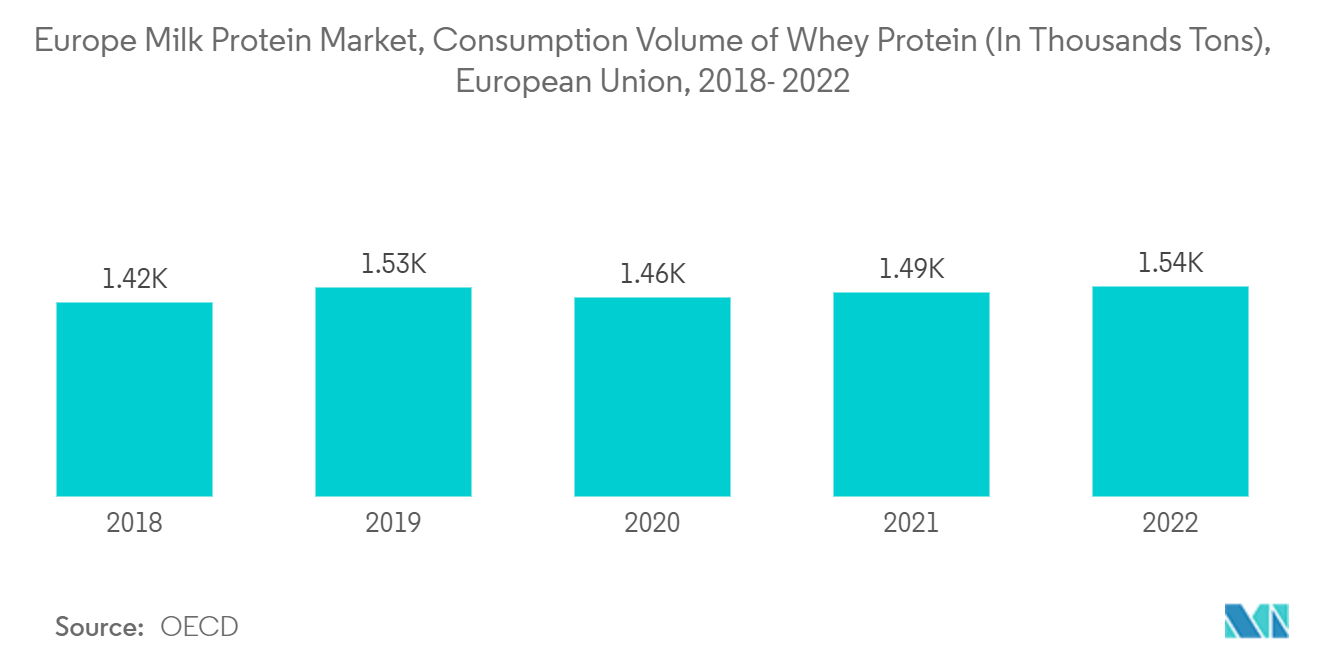
United Kingdom Holds the Largest Market Share
- Milk protein is being used more frequently in the food and beverage industry's wide range of goods, such as infant formula, functional foods, and sports nutrition. The market has benefited from government initiatives to provide food security and nutritional needs, as well as from regulations that assist the dairy industry.
- The trend towards nutrient-dense and healthful diets, rising health awareness, and more research and development to enhance the functionality, scent, and flavor of dairy protein ingredients are all expected to contribute to the growth of the milk protein market in the United Kingdom over the coming years. The market is also anticipated to be driven in the coming years by an increase in the number of births and an increase in protein consumption to gain additional nutrients from protein supplements. For instance, there were 605,479 live births in England and Wales in 2022, according to the Office for National Statistics.
- The expansion of the sports nutrition and fitness industries has raised demand among athletes and fitness fans for milk protein supplements. Sports nutrition consumption is rapidly increasing as sports participation has increased. For instance, in 2022, the number of professional sports players in the United Kingdom was 12.9 thousand, according to the Office for National Statistics (UK), which has increased market demand.
- As one of the largest gluten-free consumers in the region, the United Kingdom remains a promising destination for milk protein consumption, owing to the ingredient's high efficacy in gluten-free formulations. Also, the whey protein demand in the country is majorly led by an increasing number of fitness enthusiasts and a heavy consumer influx in gyms and fitness clubs. The number of health clubs in the United Kingdom was 202 in 2022, according to the International Health, Racquet & Sportsclub Association (IHRSA).
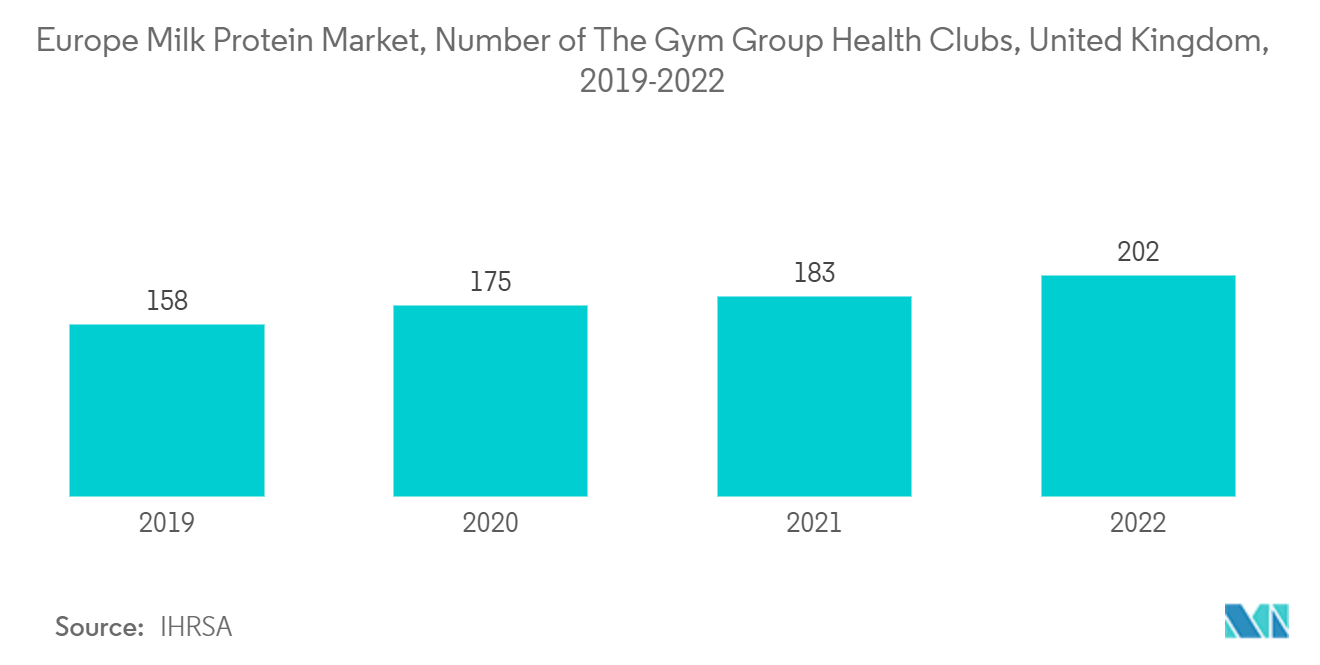
Europe Milk Protein Industry Overview
The Europe milk protein market is fragmented, with the presence of local and international players. The major players in this market are Agrial Group, Arla Foods amba, Glanbia PLC, Lactoprot Deutschland GmbH, and Royal FrieslandCampina NV (sorted alphabetically). The major players focus on product development, mergers and acquisitions, partnerships, and expansion to strengthen their position in the market. High investments in R&D activities and product innovations have led them to gain a major market share.
For instance, in February 2021, Arla Foods amba launched a new dry-blend protein that helps infant formula manufacturers reduce production costs without compromising safety or quality. It is known to be the first protein ingredient designed for dry blending. This process allows manufacturers to reduce energy usage and production costs.
Europe Milk Protein Market Leaders
-
Agrial Group
-
Arla Foods amba
-
Glanbia PLC
-
Lactoprot Deutschland GmbH
-
Royal FrieslandCampina NV
*Disclaimer: Major Players sorted in no particular order
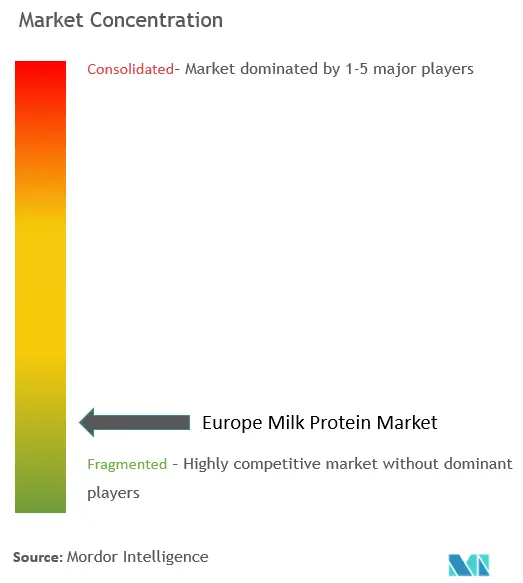
Europe Milk Protein Market News
- January of 2023: Molvest made a significant stride in Russia's dairy industry by introducing the country's inaugural milk protein concentrate production facility, effectively reducing imports by 25%. With an investment totaling nearly RUB 2 billion, Molvest Group inaugurated state-of-the-art processing facilities at its Kalach site in the Voronezh Region, dedicated to the high-intensity processing of milk to produce premium-quality milk protein concentrate.
- November 2022: Arla Foods entered into a strategic partnership with First Milk to produce specialized whey protein powder. This innovative product is manufactured at the Lake District Creamery, operated by the esteemed British dairy cooperative First Milk, in collaboration with Arla Foods Ingredients.
- August 2021: Arla Foods Amba introduced MicelPure Milk Protein, a micellar casein isolate available in both standard and organic variants. This cutting-edge product boasts a remarkable 87% content of native proteins, further exemplifying Arla Foods' commitment to delivering top-quality dairy products.
Europe Milk Protein Market Report - Table of Contents
1. INTRODUCTION
- 1.1 Study Assumptions and Market Definition
- 1.2 Scope of the Study
2. RESEARCH METHODOLOGY
3. EXECUTIVE SUMMARY
4. MARKET DYNAMICS
-
4.1 Market Drivers
- 4.1.1 Rising Health and Wellness Trends Drives the Market
- 4.1.2 Rising Demand for functional Food Drives the Market
-
4.2 Market Restraints
- 4.2.1 High Competition from Other Protein Sources
-
4.3 Porter's Five Forces Analysis
- 4.3.1 Threat of New Entrants
- 4.3.2 Bargaining Power of Buyers/Consumers
- 4.3.3 Bargaining Power of Suppliers
- 4.3.4 Threat of Substitute Products
- 4.3.5 Intensity of Competitive Rivalry
5. MARKET SEGMENTATION
-
5.1 By Form
- 5.1.1 Concentrates
- 5.1.2 Isolates
-
5.2 By Country
- 5.2.1 Belgium
- 5.2.2 France
- 5.2.3 Germany
- 5.2.4 Italy
- 5.2.5 Netherlands
- 5.2.6 Russia
- 5.2.7 Spain
- 5.2.8 Turkey
- 5.2.9 United Kingdom
- 5.2.10 Rest of Europe
-
5.3 By End-User
- 5.3.1 Animal Feed
- 5.3.2 Food and Beverages
- 5.3.2.1 Bakery
- 5.3.2.2 Beverages
- 5.3.2.3 Breakfast Cereals
- 5.3.2.4 Condiments/Sauces
- 5.3.2.5 Dairy and Dairy Alternative Products
- 5.3.2.6 RTE/RTC Food Products
- 5.3.2.7 Snacks
- 5.3.3 Supplements
- 5.3.3.1 Baby Food and Infant Formula
- 5.3.3.2 Elderly Nutrition and Medical Nutrition
- 5.3.3.3 Sport/Performance Nutrition
6. Competitive Landscape
- 6.1 Srategies Adopted By Leading Players
- 6.2 Market Share Analysis
-
6.3 Company Profiles
- 6.3.1 Agrial Group
- 6.3.2 Arla Foods amba
- 6.3.3 Fonterra Co-operative Group Limited
- 6.3.4 Glanbia PLC
- 6.3.5 Groupe Lactalis
- 6.3.6 Hoogwegt Group
- 6.3.7 Kerry Group PLC
- 6.3.8 Lactoprot Deutschland GmbH
- 6.3.9 Laïta
- 6.3.10 MEGGLE GmbH & Co. KG
- 6.3.11 Royal FrieslandCampina NV
- 6.3.12 Savencia Fromage & Dairy
- *List Not Exhaustive
7. MARKET OPPORTUNITIES AND FUTURE TRENDS
** Subject To AvailablityEurope Milk Protein Industry Segmentation
Milk protein is a protein product derived from skim milk powder. It is produced by manufacturers utilizing filtering techniques such as microfiltration, ultrafiltration, and diafiltration.
The European milk protein market is segmented into form, end user, and country. Based on form, the market is segmented into concentrates and isolates. Based on end-users, the market is segmented into animal feed, food and beverages, and supplements. Based on the country, the market is segmented into Belgium, France, Germany, Italy, Netherlands, Russia, Spain, Turkey, the United Kingdom, and the rest of Europe.
The market sizing has been done in value terms in USD and volume terms in tons for all the abovementioned segments.
| By Form | Concentrates | |
| Isolates | ||
| By Country | Belgium | |
| France | ||
| Germany | ||
| Italy | ||
| Netherlands | ||
| Russia | ||
| Spain | ||
| Turkey | ||
| United Kingdom | ||
| Rest of Europe | ||
| By End-User | Animal Feed | |
| Food and Beverages | Bakery | |
| Beverages | ||
| Breakfast Cereals | ||
| Condiments/Sauces | ||
| Dairy and Dairy Alternative Products | ||
| RTE/RTC Food Products | ||
| Snacks | ||
| Supplements | Baby Food and Infant Formula | |
| Elderly Nutrition and Medical Nutrition | ||
| Sport/Performance Nutrition |
Europe Milk Protein Market Research FAQs
How big is the Europe Milk Protein Market?
The Europe Milk Protein Market size is expected to reach USD 336.70 million in 2024 and grow at a CAGR of 4.81% to reach USD 425.80 million by 2029.
What is the current Europe Milk Protein Market size?
In 2024, the Europe Milk Protein Market size is expected to reach USD 336.70 million.
Who are the key players in Europe Milk Protein Market?
Agrial Group, Arla Foods amba, Glanbia PLC, Lactoprot Deutschland GmbH and Royal FrieslandCampina NV are the major companies operating in the Europe Milk Protein Market.
Which region has the biggest share in Europe Milk Protein Market?
In 2024, the Turkey accounts for the largest market share in Europe Milk Protein Market.
What years does this Europe Milk Protein Market cover, and what was the market size in 2023?
In 2023, the Europe Milk Protein Market size was estimated at USD 320.50 million. The report covers the Europe Milk Protein Market historical market size for years: 2019, 2020, 2021, 2022 and 2023. The report also forecasts the Europe Milk Protein Market size for years: 2024, 2025, 2026, 2027, 2028 and 2029.
Europe Milk Protein Industry Report
Statistics for the 2024 Europe Milk Protein market share, size and revenue growth rate, created by Mordor Intelligence™ Industry Reports. Europe Milk Protein analysis includes a market forecast outlook to for 2024 to 2029 and historical overview. Get a sample of this industry analysis as a free report PDF download.



